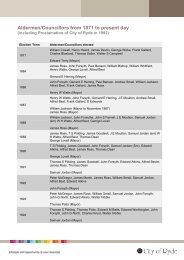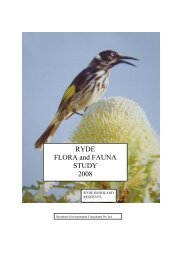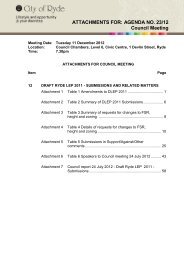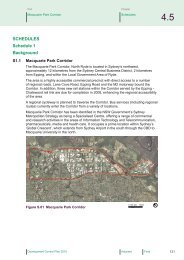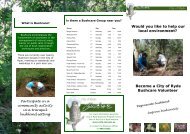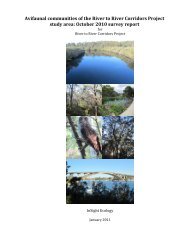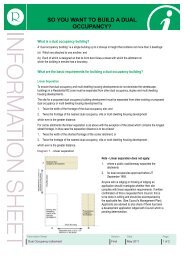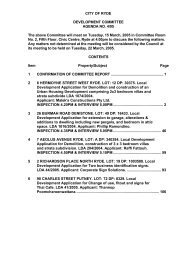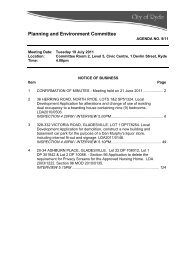RYDE FLORA and FAUNA STUDY 2007 - City of Ryde - NSW ...
RYDE FLORA and FAUNA STUDY 2007 - City of Ryde - NSW ...
RYDE FLORA and FAUNA STUDY 2007 - City of Ryde - NSW ...
Create successful ePaper yourself
Turn your PDF publications into a flip-book with our unique Google optimized e-Paper software.
Biosphere Environmental Consultants Pty Ltd<br />
<strong>Ryde</strong> Flora <strong>and</strong> Fauna Survey <strong>2007</strong> 26<br />
Pidding Park, <strong>Ryde</strong><br />
Pidding Park, <strong>Ryde</strong> is a narrow reserve bordering Pidding Road. An old tip site on the<br />
upper slopes <strong>of</strong> the park has been filled in <strong>and</strong> flattened to form an oval. Fill from the<br />
oval has been pushed downslope into the park so that healthy native bushl<strong>and</strong> only<br />
encompasses the lower 50 - 60 m just above Pidding Road. Barton Reserve is across<br />
the road <strong>and</strong> just to the southeast is the Field <strong>of</strong> Mars Reserve. The park is dominated<br />
by Blackbutt, E. resinifera (Red Mahogany), Corymbia gummifera (Red Bloodwood),<br />
Angophora costata (Sydney Red Gum) with a variety <strong>of</strong> shale loving shrubs<br />
(Leucopogon juniperinus) <strong>and</strong> sclerophyllous vegetation. A quadrat was situated in<br />
Pidding Park to determine boundary <strong>of</strong> the Turpentine Ironbark Margin Forest with<br />
the Western Sydney Gully Forest. There is high diversity (60 species) in the s<strong>and</strong>yclay<br />
soil <strong>of</strong> the quadrat despite erosion <strong>and</strong> evidence <strong>of</strong> rabbits that are destroying<br />
some new plant growth. There are some s<strong>and</strong>stone outcrops within Pidding Park <strong>and</strong><br />
the quadrat fulfils the criteria for two Map Units; Map Unit 43: Turpentine Ironbark<br />
Margin Forest <strong>and</strong> Map Unit 33: Western S<strong>and</strong>stone Gully Forest (Tozer, 2003). The<br />
quadrat was also tested for Map Unit 2: Shale S<strong>and</strong>stone Transition Forest (high<br />
s<strong>and</strong>stone influence) but failed as it was lacking by 6 positive diagnostic species. An<br />
environmental burn was conducted mid year in the northern end <strong>of</strong> the reserve <strong>and</strong><br />
may have affected the overall species count for the whole reserve as there were only<br />
68 species observed for the whole park. It did not affect the area in which the<br />
quadrat is located.<br />
There are two weeds to note in Pidding Park: the Class 3 Noxious Weed, Paspalum<br />
quadrifarium (Tussock Paspalum) <strong>and</strong> Pavonia hastata, which are widespread,<br />
especially in the north end <strong>of</strong> the park where the environmental burn occurred.<br />
Field <strong>of</strong> Mars Reserve, <strong>Ryde</strong><br />
Two quadrats were erected in the spring, following recommendations from the<br />
previous report in 2006. Oculus (1999) mapped the upper Strangers Creek area as<br />
Sydney Turpentine Ironbark Forest. This area contains plants found within the<br />
endangered Turpentine Ironbark assemblage (DECC, 1998) <strong>and</strong> fulfils Map Unit 43:<br />
Turpentine Ironbark Margin Forest (Tozer, 2003). The soils are high in clay <strong>and</strong><br />
laterite. The north-west corner <strong>of</strong> the reserve, is dominated by a forest <strong>of</strong> Red<br />
Mahogany, Turpentine, <strong>and</strong> Sydney Red Gum. There is a walking track through this<br />
community connecting the S<strong>and</strong> Track with the Strangers Creek track. Arson occurred<br />
in 2002 <strong>and</strong> there has been excellent regeneration after the fire. There are numerous<br />
uncommon plants in the area: Pultenaea villosa, Acacia brownii <strong>and</strong> Acacia stricta<br />
(Kubiak, 2005), while Pultenaea retusa is listed as vulnerable in western Sydney<br />
(Benson & McDougall 1991). Epacris purpurascens var purpurascens, listed as<br />
vulnerable in Schedule 2 <strong>of</strong> the TSC Act (DECC <strong>NSW</strong>, 1999), is scattered throughout<br />
the area.<br />
Oculus (1999) also mapped a Shale S<strong>and</strong>stone Transition Forest area just east <strong>and</strong><br />
another just north <strong>of</strong> the Cemetery on clay soil. Shale S<strong>and</strong>stone Transition Forest<br />
assemblage is listed as an endangered ecological community (DECC <strong>NSW</strong>, 1998).<br />
The canopy contains Red Mahogany with a Eucalyptus racemosa (Scribbly Gum),<br />
Red Bloodwood <strong>and</strong> Sydney Red Gum understorey. Within this community are<br />
numerous rare plants: Gompholobium pinnatum <strong>and</strong> Pultenaea paleacea <strong>and</strong><br />
uncommon plants: Acacia brownii <strong>and</strong> Pultenaea retusa (Kubiak, 2005). Pimelia




